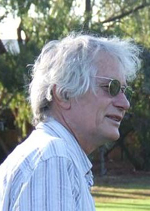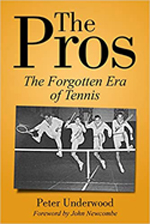Bush Childhood
Peter Underwood

It started in Queensland, the state Aussies sometimes call --with a mixture of respect and derision--the Deep North. On August 9, 1938, in the northern coastal town of Rockhampton (population 33,500), Roy and Melba Laver greeted the arrival of their third child.
He was a healthy boy. Named Rodney George, he was to become Rockhampton's most famous son.
Only a month after the birth, an event occurred on the other side of the world. Although apparently unrelated, it was eventually to have far reaching consequences in the life of the new baby.
Another redhead, the American Don Budge, completed the first ever Grand Slam. And as young Rod developed his game, it became is dream to repeat Budge's odyssey that coincided with his birth.
The Lavers were a rural clan of bushmen and sportsmen. And the women too. Only days before she died at ninety, Rod's grandmother was still riding a horse. Father Roy ran cattle stations—ranches--and at times worked as a butcher.

Mother Melba was named after the famous Australian opera singer Dame Nellie Melba, who had idolized Big Bill Tilden. She was the aunt of the Australian player Gerald Patterson, the man that Tilden vanquished for his first major.title at Wimbledon in 1920. (For more on that win by Tilden, Click Here.)
The baby was taken back to Langdale, a smallish cattle station Roy managed, just out from Rockhampton. When Rod was eight years old, the family moved to another station 30 miles from Marlborough, and over 70 miles inland from Rockhampton.
Marlborough, a hot little cattle town, had a primary school for Rod, as well as a local butcher's shop that his father ran along with the station. But within a year, Roy and Melba decided they wanted a better education for their children, and moved the family back to Rockhampton.
Thus Rod Laver's early boyhood was shaped by two major influences: the spirit of the Laver tribe, and the Queensland bush. In Aussie lingo, he was a "bananabender from beyond the Black Stump."
The Lavers were a large clan--proud and tough. And passionate about sport. Uncle Frank Laver had played cricket for Australia. Father Roy was one of 11 boys, and the Laver lads made up a whole cricket team widely celebrated in the outback. But in the nuclear family, it was tennis that held pride of place.
The Ant Hill

The Lavers built their own tennis courts. The means of construction was indigenous. Excavating the ubiquitous giant anthills, they crushed the red dirt, laid it down, then leveled and rolled it. The result was a surface softer than concrete that played like fastish clay.
On weekends, competitive and social tennis was at the center of their little community. The bush families would gather at one or another of their neighbors' homes, a visit sometimes requiring a journey of over 100 miles.
When Rod was nine and back in Rockingham, the first thing the Lavers did was build an another anthill court. To clear the space they removed scrub and trees thick enough to hide a venomous six foot brown snake. Someone managed to dispatch the intruder with a tennis racket.
This court was fenced in by chicken netting. It was also lit, if somewhat dimly, to enable play in the cooler evenings. Four great hanging 1500 watt globes were strung down the center axis of the court.
One night in 1948 the Laver court was ablaze under the lights. The tennis was on. Just a few yards away, a young boy had been put to bed but was unable to sleep. The lad was now 10 years old and the youngest of the boys in the extended family. Stealing from his bed, he crept down to the scene of family activity. Pajama clad, the little red-haired kid reached the court and, enthralled by the goings on under the lights, gripped the chicken-wire fence with his hands.
Seeing the delight of his older brothers, he could not help asking himself: why was it that everyone else was having all the fun? But the lad was so shy, he decided that if he kept out of the way no one would notice him, and he could continue worshipping these dashing figures in white.

Student and Master
But someone did notice him. The Lavers had invited a visitor to play with them. He was a tall man and elegant. Suddenly he spied the little boy hanging on the wire. In one encompassing glance, the die was cast.
There is a saying in the East that when the student is ready, the master is found. One sweaty night in Rockhampton, the meeting of master and student became peculiarly destined.
The tall visitor was Charles (known as Charlie) Hollis, and he was a pro. His job was teaching tennis. The shy boy was to become his most famous pupil.
Who was he? At that time Charlie was about 40 years old, and a bachelor. In his autobiography, The Education of a Tennis Player, Rod says that the residence of this particular bachelor was one of the town's hotels.
In those days every dusty township seemed to harbor one or two men or women with a stamp so individual as to make them renowned (for good or ill) in the community: they were the local characters.
For many, like Charlie, the scars of war contributed to their choice to live outside a nuclear family. They joined a group that provided for them.
As if to relish--and publicize –the status of permanent guest, some would cultivate a sense of style. These individuals wished to be seen in the town as a person of some class.
Mr Hollis, as the local children called him, was one such character. One photo catches him in his soldier's uniform at the war's end. His arm bears the distinction of the sergeant's stripes, and with open bushland as his backdrop, he confronts the camera boldly. To the Laver clan, he cut his jib distinctively. This tall and suave man was a fastidious dresser and took pride in his manners and social grace.

Charlie Hollis was set apart by his style, his itinerant past and his lack of a conventional occupation, or the trappings of domesticity. To the bush communities, here was the real thing--a true pro with cachet.
Tennis was his life. Charlie was never a top player, but he had been a good one, and his vocation was teaching the game he loved. For years he had floated around northern New South Wales, and then North Queensland, before ending up in Rockhampton. There he instructed the locals, and visited the little towns and schools in the hinterland. It was the Lavers who had lured Charlie to Rockhampton to set up his coaching school. As soon as their anthill court was ready, even without other guests, Charlie could always find sufficient numbers for a decent game among hosts Roy and Melba and Rod's older brothers, Trevor and Bob.
The older boys were becoming good. Ambitious for his sons, Roy was forever pressing Charlies to improve their tennis.

On that particular night in 1948, Charlie was, as usual, displaying the ample riches of his game. Watching him cracking his long ground strokes from both wings, and acing the opposition with an easy swinging serve, the older Laver boys were captivated. As for the kid brother in his pajamas, he believed he'd never see anyone play so beautifully.
It was between sets, over a tot of rum, that Charlie spied the child hiding behind the chicken-wire fence. Speculating that it must be the youngest Laver, the elegant visitor abruptly turned to Roy. "Now then, Roy," he asked, who's that kid hanging on the wire?' Roy Laver, surprised at finding his youngest still up, told Charlie who he was. "He's keen," said Charlie Hollis imperiously. "Let the little bugger have a hit."
In keeping with all the best legends, this pupil was shy, astonished, eager and unknown, and his first step towards fame and fortune was made barefoot. In nothing but his pajamas, the tiny youngster was brought in and handed his mother's racket. Before half a minute had passed, he was tearing all over the court trying to return the ball to the visitor.
At once, Hollis recognized the boy's exceptional ball sense. "He's got an eye like a hawk," Charlie informed Roy and Melba. Despite this, at first Charlie considered that the kid might be too small to get anywhere--but before long, he changed his mind and took him on. Master and Student had found each other.





